Menu
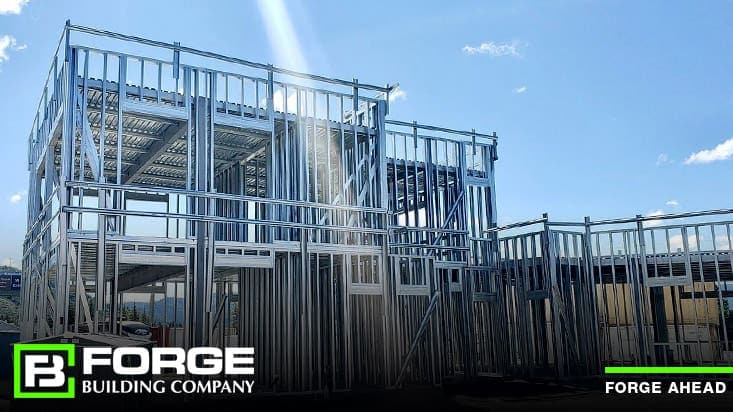
When it comes to building storage facilities or other commercial construction projects, custom steel buildings are an excellent choice. There are many factors that make commercial steel buildings a solid choice, including versatility, durability, energy efficiency, quicker builds, low maintenance, and cost effectiveness. Finding the right Commercial Steel Building Developers for your steel building project is crucial to your success. Erecting a metal building is a significant investment; your metal building contractor can make or break your project. So, keeping all of these factors in mind, it is a priority to find the right steel building contractor who can help design and develop the most cost-efficient commercial steel building that meets the requirements.
Commercial steel buildings are versatile and customizable to meet the project's needs. Steel buildings offer strength and the ability to be expanded as requirements change. The strength of the steel beams allows for a wide-open construction for large space requirements.
You can even achieve the appearance you are looking for with features like brick facades, wood veneers, vinyl siding or even stonework. The solid framework of a steel building allows for the inside to be remodeled easily as your needs change.
The construction of a steel building offers cost efficiency for the initial construction as well as the cost of ownership over time. For example, a steel building can be less expensive to insure as it offers resistance to fire damage. The strength and durability of a commercial steel building is built to last and should require less structural maintenance over the years of ownership.
Additional savings can come from lower maintenance requirements versus traditional wood or brick construction. The steel frame and metal panels are safe from the destructive effects of termites that can cause expensive damage.
Properly constructed commercial steel buildings offer excellent interior temperature protection. With proper insulation, ventilation, and HVAC service the interior climate can be preserved during extreme heat or cold weather. This is key for storage unit contractors. The building can also be designed in a way that encourages natural air flows that help with ventilation and comfort. This can be extremely important for use in commercial storage facilities.
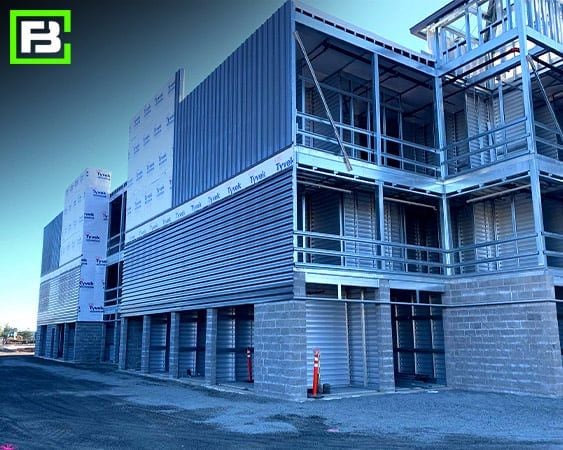 A commercial steel building can be built in much less time than a traditional brick or wood building. Commercial steel buildings are designed off site and made to fit together quickly and efficiently. This faster build time can make a big difference in carrying costs as well as construction costs. The shorter the construction time the sooner you can be utilizing the new building. This can mean faster revenue for your business or savings from being able to leave a less cost-effective location sooner.
A commercial steel building can be built in much less time than a traditional brick or wood building. Commercial steel buildings are designed off site and made to fit together quickly and efficiently. This faster build time can make a big difference in carrying costs as well as construction costs. The shorter the construction time the sooner you can be utilizing the new building. This can mean faster revenue for your business or savings from being able to leave a less cost-effective location sooner.
Steel metal buildings are now being used as warehouses, distribution centers, and industrial facilities. Commercially they are also used for office, government, and retail sectors. According to the Metal Building Manufacturer Association, shipments have grown to 1,094,064 tons in 2017 and this growth continues today. That’s why it is crucial to work with the most qualified commercial steel building contractor for your project.
One great example is where the team at Forge Building Company completed the Coppertop Storage Facility in Washington state. This 18,000 square foot pre-engineered steel building was added to an existing business park.
When selecting a steel building contractor, it is key to work with one that has created custom steel buildings of every shape and size. It is also most cost-effective and efficient when working with a company that:
The right steel building contractor should also be able to provide:
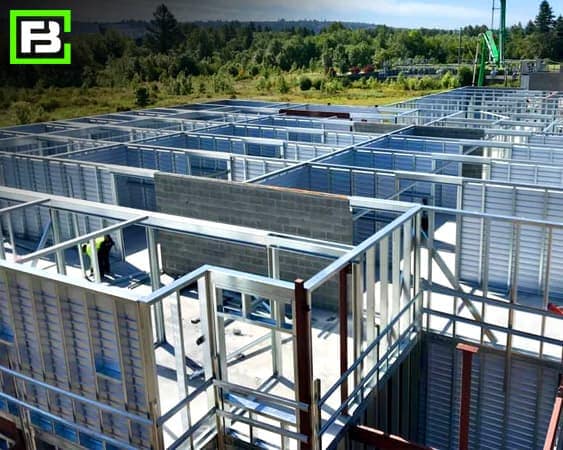 The most important factor when choosing between different metal building contractors is making the right choice. But the right choice will be different for different people. This is because everyone has different requirements and preferences. Therefore, the best way to make the right choice is to outline your requirements.
The most important factor when choosing between different metal building contractors is making the right choice. But the right choice will be different for different people. This is because everyone has different requirements and preferences. Therefore, the best way to make the right choice is to outline your requirements.
So, to make a proper decision, we recommend that you first decide which criteria are most important to you. It is helpful to divide your analysis into a few key areas. The features to consider include the following.
The first consideration should be what products and services the company offers. No metal structure is the same. So, if a company doesn’t offer the products and services necessary to help you achieve your specific project, it isn’t the right company for you.
This is why it is so important to have clear plans beforehand. If you have a clear idea of what you need to build and the services you require to build it, then you can easily see which company offers the best range of services.
Certain companies specialize in building different types of metal structures. Different companies also offer different construction services to help you build the structure. Know what you are looking for and find the company that offers it.
Of course, having the proper certifications to do the work offered is pretty much a bare minimum for any construction company. However, while not a concrete rule, you can expect a contractor with more certifications to have a better understanding of the industry. And while a more experienced company may cost a bit more, the extra experience is often worth it for the higher level of service.
Of course, price is a valid consideration in just about any decision you make. However, when shopping based on price, it’s best to think in terms of the quality that you are receiving for that price.
Price alone isn’t a very good metric because it doesn’t consider what you are getting for what you pay. You should first decide on which products and services you want and then shop based on price. See which company can give you the most value for the best price, and that’s the decision you want to make. Do your research on average costs to build self storage facilities in your market.
Client support is also a big one. This is especially important in this industry. Ongoing support is important when you have frequent questions about your construction process and steel building materials.
With metal building companies, look for one with a client support line that is easy to reach and covers many hours of the day. And with a construction service, good client support also includes a competent and efficient construction team.
Overall, try to find a company that is friendly, responsive, and very knowledgeable about their products and services. They should also be quick to solve any problems or issues that may arise.
It’s a great idea to research a company by looking at their website and their service offerings. To get a truly objective view of a company’s competence, you should be looking at client reviews.
These are just a few of the qualities that make custom steel buildings the right choice for business use cases. When you are ready to choose Commercial Steel Building Developers who can help you achieve your goals, the team at Forge Building Company will be ready to serve you.
To view our pre-engineered steel buildings, see our completed projects
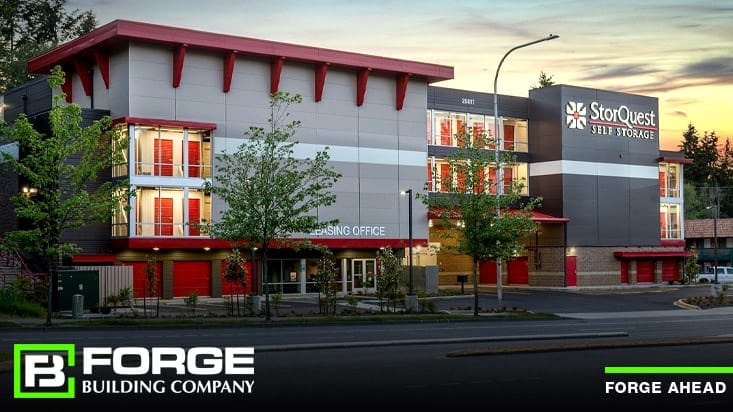
Storage facilities are found virtually everywhere in the U.S. In fact, self-storage units are among the highest-yielding real estate investments on the market. Once maintenance and security are in place, owners are free to collect numerous rent checks per square foot. Moreover, storage facilities remain buoyant during poor economic conditions.
The United States is the main player in the self-storage industry, where the industry is estimated to be worth $38 billion. There are approximately 50,000 storage unit facilities throughout the U.S offering more than 2.3 billion square feet of self-storage space.
About 18% of the industry is owned by the top five players, U-Haul and four (4) REITs (real estate investment trusts). This fact illustrates that there are numerous small, independent self-storage operations throughout the country building storage units. At any given time, about 10% of American households rent commercial storage units.
Life events such as moving, divorce and even death often trigger the need for temporary and long-term storage. It’s no wonder that more and more investors are looking for contractors to build commercial storage buildings.
Competition among self-storage units is greatest in metropolitan areas, where available, properly zoned land is at a premium. Many units are manufactured modular buildings that are easy and relatively quick to assemble. For this reason, building storage units has never been easier or more cost-effective.
 Vacant land can become an income producing asset for landowners looking to increase revenue. Land is valuable, and while land may be most valuable when a structure is built on it, this doesn't mean it can start producing income immediately. It all takes proper planning with the right steel building contractor that fully understands the entire process from land acquisition to the architectural process to final construction.
Vacant land can become an income producing asset for landowners looking to increase revenue. Land is valuable, and while land may be most valuable when a structure is built on it, this doesn't mean it can start producing income immediately. It all takes proper planning with the right steel building contractor that fully understands the entire process from land acquisition to the architectural process to final construction.
If you’re in the position of buying land for the purpose of converting it into a commercial storage development, you’ll need to understand a few things.
The minimum size of a self-storage facility is usually 40,000 square feet of rentable space, which typically requires two to three acres of land. The best sites are situated at major intersections that are easy to access and near a high, population density in a growing region.
Ideally, a self-storage facility would be free of nearby competitors and would also be close to a retail center. Of course, local zoning must permit building storage units in that specific location. So it is key to understand:
Every lot is different. You will likely have the option of using the equity in the land to pay the down payment on a construction loan. A lot goes into the development process, and lenders want to ensure they have as little risk as possible when lending money.
Putting the land up as equity when owned allows you to avoid paying cash for the down payment. Some lenders may require a cash investment, but this varies from lender to lender.
Once your loan is approved, you can begin developing the land into an income-producing storage facility. Storage units can generate a lot of revenue when you have the right structure built for that particular area.
In a previous blog titled “Building a Commercial Storage Building” we covered how to successfully build and develop a self-storage facility.
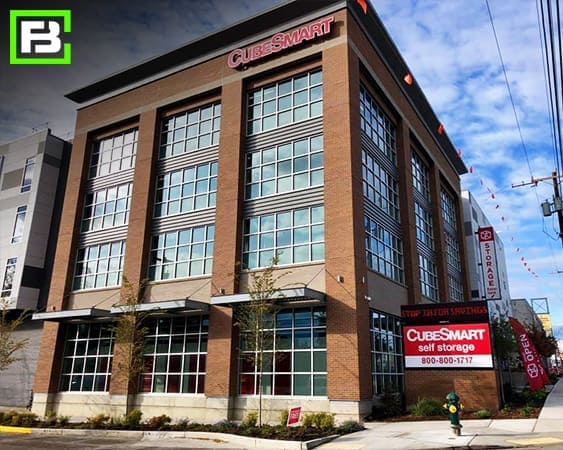 Self-storage buildings offer a variety of individual storage rooms. In square feet, the most popular storage room sizes include: 5×10, 10×10, 10×20, 10×30, 15×20 and 20×20 (the later of which is approximately the same size as a two-car garage).
Self-storage buildings offer a variety of individual storage rooms. In square feet, the most popular storage room sizes include: 5×10, 10×10, 10×20, 10×30, 15×20 and 20×20 (the later of which is approximately the same size as a two-car garage).
The units typically have corrugated-metal walls, no windows and can be locked by the renter/tenant. Access to the facility may be secured by clerical staff, security guards, digital gate codes, alarms and security cameras.
Individual units might have a conventional lock or perhaps something more high-tech, such as a keypad, card reader, or biometric scanner. Higher-end units provide climate control, around the clock access, and power outlets within individual units.
For a sample of the types of single-story self-storage buildings that Forge offers, please check out: Single-Story Self-Storage Building Contractors.
Here are three points you should consider before hiring a storage building contractor:
The cost to build storage units starts with land costs and parcel sizes. A facility of 40,000 square feet requires a land parcel size of 2 to 3 acres. You need 3 to 4 acres for 60,000 square feet and 4 to 5 acres for 80,000 square feet, and so on.
Generally, about 40% of a storage facility’s client base demands climate-controlled units. This feature increases rental prices 25% to 60%, but costs only 10 cents per square foot! In other words, climate control has an incredibly high return on investment (ROI).
The coverage ratio of a site is the amount of land covered by the storage facility. For example, if you have 6,000 square feet of coverage on an 8,000 square foot lot, your coverage ratio is 75%. Naturally, the higher the ratio, the more revenue you can squeeze out of the storage facility. So bear that in mind before you start building storage units.
For single-story units, expect to pay $25-$40 per square foot, but multistory self-storage units typically cost $42-$70 per square foot. Additional cost factors like electricity, plumbing, and security systems can add $15-$45 per square foot. (source: Assets America)
In terms of constructing storage unit buildings, the cost can be relatively affordable. Depending on the region and building size, expect to pay $25,000-$100,000 for simple, steel buildings with 10-50 units. The cost to build storage units can be surprisingly within reach.
Developing land is a costly venture but finding the funds to develop the land with the best steel building contractor will also reap the highest return on investment.
Costs have changed since the posting of this blog. The hard and soft costs of construction will vary from project to project. Let’s break it down.
Keep in mind, that prices in materials, such as steel, may fluctuate and this directly impacts the cost per square foot. Also, you may be building in an area that is experiencing labor shortages causing the labor prices to increase as well.
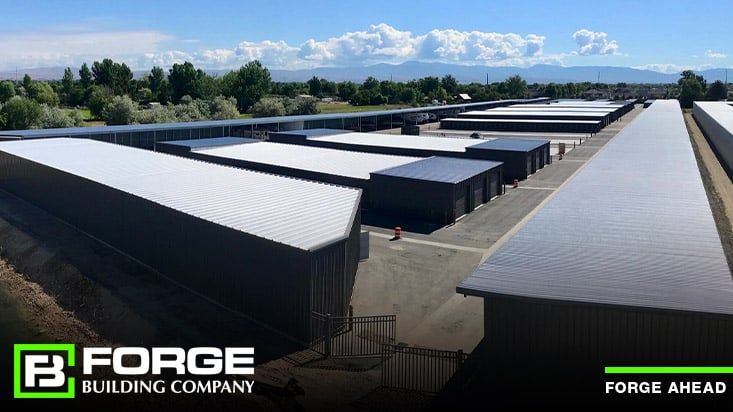
Through both good and bad economic times, the self-storage sector has proven to be a steady performer. That’s why so many investors want to get a piece of the action. To do so, you can either buy an existing self-storage facility or develop a new one. Successfully building a commercial storage building involves several factors, including choosing the right site, design, the correct unit mix, and layout. This may sound simple, right? Not so fast. Read more about these fundamentals and get advice on how to achieve optimal results.
If you go down the development path, one key question is: How much money will you need? There’s no simple answer to that question, as the cost can vary based on several factors, such as location and the number of self-storage units.
Ultimately, the goal of any self-storage development should be financial success, and the best way to accomplish that is to carefully plan the basics: site selection, unit mix, and layout. For many, the industry business model looks simple: buy land, build, and make money. It may once have been that simple, but today, it’s much more complex.
The commercial storage building market, like many similar markets are experiencing greater competition, higher land and building costs, and additional regulatory burdens. The industry, in general, is seeing the use of more climate-controlled and multi-story buildings, due in part to trends in consumer demand. As a result, self-storage facilities are becoming much more expensive to develop, with longer lease-to-stabilization times. Even so, they continue to be a solid investment choice.
Choosing the right site and creating a well-designed unit mix and layout is critical, especially for a first-time developer. These are the fundamentals of building a successful storage business, whether you’re building your first or fortieth facility.
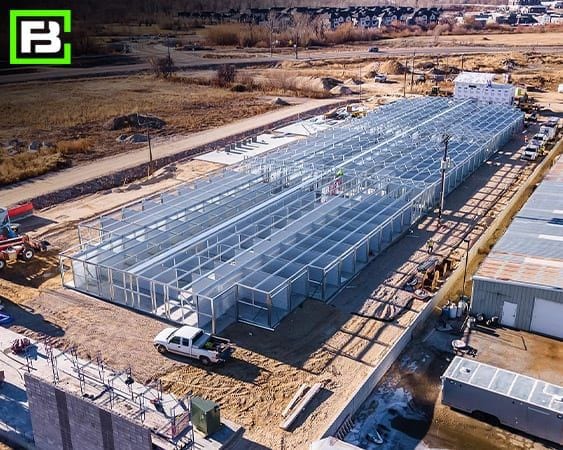
Site selection is the most critical factor in planning for the success of a commercial storage building. It is important to select a highly visible location, has good access, and is located on a major road. The site should be in a high-growth area or one that’s clearly in the path of progress for that region. In addition, it’s key to look for a good combination of demographics, with higher-than-average household income and population growth within a three-mile trade area. Finally, the location should have minimal existing or planned self-storage competition, particularly within the first few miles.
When you discover an area that’s underserved, chances are other self-storage building manufacturers and developers have noticed it as well. Check with the local building authority to see what’s being planned before starting a building project. You don’t have to let competitive forces sway your decision but it’s good to be aware of all existing and planned projects.
Once the site selection is determined, it is key that the property is large enough for your planned development and that it has access to the proper utilities, such as water, sewer, and electricity. It should also be properly zoned.
It is critical to understand that not all land is good for self-storage. A good site must have the attributes discussed previously. If it doesn’t, it is best to keep looking for one that does.
Typically, a single-story self-storage development might require three to five acres, depending on topography and shape. Whereas a multi-story self-storage site may only require two acres or so. The ideal site should give you a high level of confidence about all of the specifics of that particular location.
Generally, you can count on a self-storage facility costing $25 to $70 per square foot to build. That range can vary greatly. For instance, the cost of steel may go up or down at any given time, or the area where you’re building the facility may be experiencing a labor shortage. And, of course, you’ll certainly face higher costs in a major metro area than you would in a small community.
Self-storage unit mix is normally a product of population density and income levels. So it is key that you understand the market in which you are building the commercial storage-units. For example, areas of higher income will typically demand more security and climate-controlled features; apartment dwellers will want smaller units, say 5-by-10s; and suburban or commercial-oriented markets will call for larger spaces, such as 10-by-20s. Also, see our article on Determining the Right Unit Mix.
It’s important to note that your financial return per square foot (PSF) usually diminishes as the size of the unit increases. For example, if your market will support $70 for a 5-by-10, you’re achieving a rental rate of $16.80 PSF. It’s doubtful the 10-by-20 will support that same rate. This doesn’t mean you should build a higher proportion of smaller units, though. A store with 50,000 net rentable square feet might have more than 500 storage units or as few as 300, depending on the market. You must build the unit mix to the market, not to skew the PSF return.
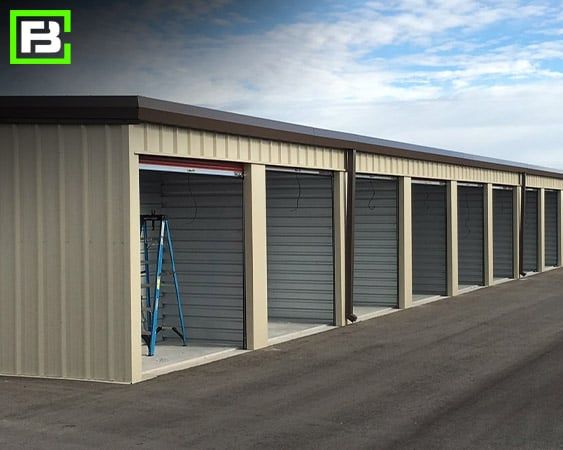
When you’re looking to develop a self-storage facility, you obviously must decide where to build it. Be prepared, finding a great site for storage can be tricky. You’ll need to find a site for the right price, with the right zoning, and the right demographics to support your business.
To discuss site layout, it’s key to understand building a single-story versus a multi-story storage facility. The layout process typically begins with the involvement of a professional civil engineer with experience in self-storage design, which can be invaluable. The goal is to maximize the net rentable square footage. You’ll typically be hunting for 2.5 to 5 acres to accommodate the facility. Land costs typically make up about 25% to 30% of the entire development budget and you will also need a site that will accommodate a minimum of 50,000 square feet, constructed all at once or in phases.
A single-story facility usually costs $25 to $40 per square foot. Construction of a multi-story facility typically costs more — $42 to $70 per square foot. These figures don’t include land or site improvement costs.
Of course, this isn’t a consideration if you already own property suited for a storage facility, although you still may need to go through the costly, time-consuming process of rezoning the land.
The layout is primarily a product of the shape and topography of the land parcel, but many other factors come into play, including:
At Forge, we normally factor in all the setbacks, easements, and storm-water restrictions first. From there, our drafters will then sketch the layout. Next, we try to determine how much climate-controlled versus non-climate-controlled storage can fit on the site. Then we look at accessibility to each of the buildings and individual units, ensuring it will be easy for clients to access their storage space. If it isn’t reasonably simple for tenants to drive in, get to their unit, and store their items, they’ll go elsewhere.
The key takeaway here is that it is critical to find the right site, then design the unit mix and layout based on that particular market. Doing the research and spending time with professional engineers and planners will help you succeed in your self-storage development. Remember, it’s a process that will involve a considerable amount of time and money, but the end reward will be worth it. At Forge, we can simplify the process by giving you a one-stop shop for all of your commercial storage building needs. Then once your new storage business is off to a solid start, you’ll be ready to focus on your next self-storage development project!
Related article: Before Construction Begins: Fundamentals of Building Self-Storage
Costs have changed since this blog was posted. The hard and soft costs of construction will vary from project to project. Let’s break it down.
Keep in mind, that prices in materials, such as steel, may fluctuate and this directly impacts the cost per square foot. Also, you may be building in an area that is experiencing labor shortages causing the labor prices to increase as well.
As builders Forge Building Company is used to risk – from labor shortages to escalating steel and construction pricing. Since 2007, self-storage developers have relied on Forge to create custom steel self-storage buildings of every shape and size. From initial concept through completed construction, the Forge team of highly certified professionals are experts at guiding clients through every step of designing and building a self-storage project. This includes site plan assistance, custom engineering, and installation.
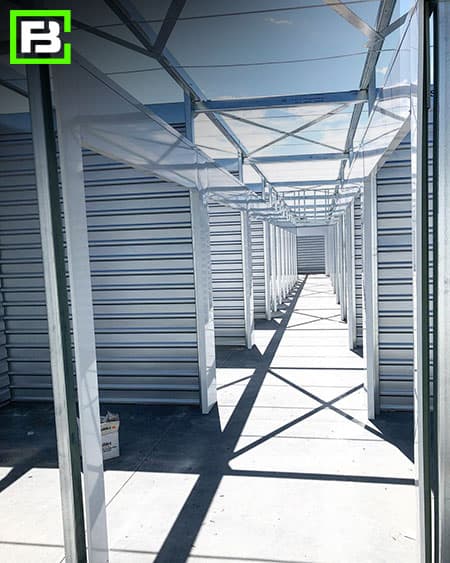 Over the last year, the company (and the industry as a whole) experienced varying degrees of impact because of the COVID-19 pandemic. Direct impacts ranged from a slowdown of available goods and labor through to suspensions and, in some instances, terminations of entire storage projects. Construction activities remained in flux in some states and cities depending upon whether construction was classified an essential business.
Over the last year, the company (and the industry as a whole) experienced varying degrees of impact because of the COVID-19 pandemic. Direct impacts ranged from a slowdown of available goods and labor through to suspensions and, in some instances, terminations of entire storage projects. Construction activities remained in flux in some states and cities depending upon whether construction was classified an essential business.
As a result, Forge took the opportunity to address both short-term and long-term business challenges, as well as formulating project-by-project solutions in the face of a new global and national environment. As a result, the company was able to forge ahead, building 45 of new self-storage steel buildings in 13 states, including Idaho, Washington, Oregon, California, Nevada, Arizona, New Mexico, Hawaii, Montana, Wyoming, Colorado, Michigan and Illinois through July of 2021.
The new realities touch almost every aspect of the construction process. Specifically, such issues as contract, scheduling, project suspension, projects being terminated and reinstatement; Occupational Safety and Health Administration (OSHA) and workplace safety compliance; workforce management; material, subcontractor and supply chain delays and impacts; risk management and insurance; claims avoidance or, alternatively, claims management; and the disputes process.
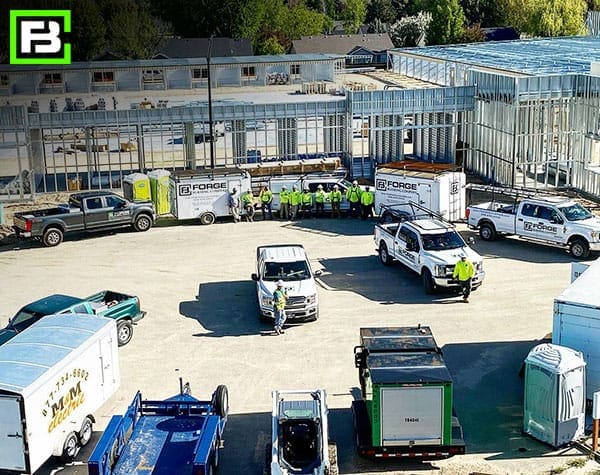
While there have only been a few reports of COVID directly impacting the U.S. construction workforce, Forge continues to be concerned with employee overall well-being. The good news is that the risk of transmission of this disease for those employed outside the healthcare sector is low, according to OSHA. Besides physical wellness, Forge is considering mental health, too, because many employers report anxiety among workers as one of the top issues brought on by the pandemic. In an informal Construction survey, 70% of respondents noted “employee anxiety” as their top concern, above material shortages and the prospect of government shutdowns.
In construction, everything comes down to time and money. Forge continues to be the leading nationwide self storage steel building contractor with an emphasis on self-storage developments. The Company has a 200+ field erect team that builds all projects for its clients, where other companies do not have their own teams and sub out the actual building proprietary. This provides consistent, innovative solutions for our clients. At Forge, the company listens to what its clients need to provide the most up-to-date, consistent solution using its proprietary methods.
Forge Building Company treats its clients, partners, and employees like family.